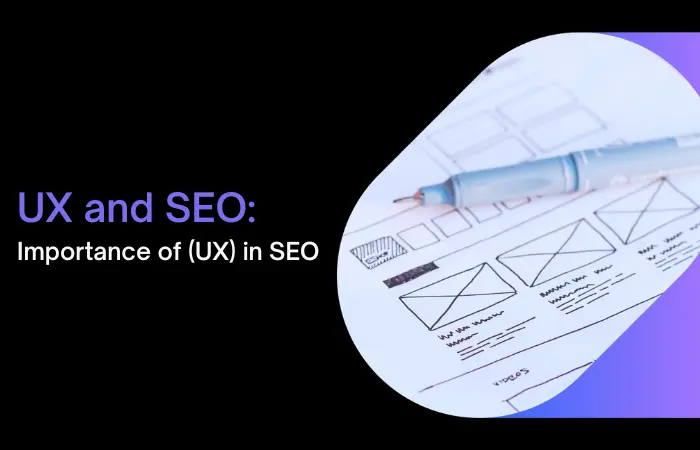User Experience (UX) is no longer just a nice-to-have feature on your website; it’s an essential part of your SEO strategy. As search engines evolve, they are increasingly placing more emphasis on how visitors interact with your site. Websites that provide a seamless, user-friendly experience are rewarded with better rankings, increased traffic, and improved conversions.
In 2025, it’s more critical than ever to understand the connection between UX and SEO. If you’re not optimizing for UX, you’re likely missing out on valuable opportunities to boost your online presence and stay ahead of your competition.
In this blog, we will discuss why UX is crucial for SEO, how it impacts your rankings, and what you can do to enhance UX on your website. Plus, we’ll share practical tips and strategies to improve user experience and ensure your site is search-engine friendly.

Why UX is a Critical Factor for SEO
SEO isn’t just about keyword optimization or building backlinks anymore. It’s about creating an experience that resonates with users and keeps them engaged. Search engines, like Google, are increasingly using advanced algorithms to measure how users interact with a site—factors such as time spent on the page, bounce rates, and click-through rates are becoming key indicators for ranking.
Here’s why UX matters so much for SEO in 2025:
Google’s Focus on User Intent
Google has become exceptionally good at understanding user intent. When someone searches for something, Google wants to show results that are the most relevant and helpful. If your website doesn’t provide a great user experience—i.e., if it’s hard to navigate, loads slowly, or doesn’t provide value to the visitor—users will bounce, and Google will notice.SEO and content marketing go hand in hand. A well-structured content strategy enhances user engagement and search visibility. Read more on how they work together in our guide: SEO and Content Marketing: A Symbiotic Relationship.
Mobile Optimization is a Must
With the majority of searches now happening on mobile devices, Google has moved to mobile-first indexing. This means that Google uses the mobile version of your site to rank it in search results. If your mobile experience isn’t optimized, your rankings will suffer, regardless of how strong your desktop version may be.For businesses aiming to improve their online visibility, ensuring a seamless mobile experience is essential. A well-optimized mobile website not only enhances user satisfaction but also plays a crucial role in SEO rankings.
Learn more in our detailed guide on Mobile Optimization: Why It’s Crucial for Your SEO Success.Page Speed and Load Time Matter More Than Ever
A slow-loading website can cost you valuable visitors. Google’s Core Web Vitals have become a ranking factor, and they are directly tied to user experience. Websites that load faster are not only favored by users but also by search engines. (Read Google’s official guide on Core Web Vitals)Improved Engagement Leads to Higher Rankings
When users find your website easy to navigate, they are more likely to stay longer, visit more pages, and interact with your content. This results in lower bounce rates and higher dwell time—all of which are positive ranking signals for Google.
How UX and SEO Work Together
While UX and SEO are often thought of as separate areas of digital marketing, they are deeply interconnected. Let’s explore how these two elements complement each other:
Page Structure and Content Organization
A clear and logical website structure enhances both UX and SEO. A well-organized site makes it easier for users to find what they need, and it also makes it easier for search engines to crawl and index your pages. Ensuring your website meets technical SEO requirements is essential for better indexing and rankings.
Follow our step-by-step Technical SEO Checklist to stay ahead.Mobile Optimization and Responsive Design
Google rewards websites that are optimized for mobile devices with higher rankings. Responsive design ensures that your site adjusts to different screen sizes, improving UX and making your website accessible to a larger audience.Content Accessibility
Good UX means that your content is accessible to everyone, including those with disabilities. Implementing accessibility features such as text descriptions for images and properly structured headings can improve your UX while also helping with SEO. (Learn more about Web Content Accessibility Guidelines (WCAG))Intuitive User Flow
When users can easily navigate your site and find what they’re looking for, they are more likely to engage with your content. A clear call-to-action (CTA) and simple, intuitive navigation paths lead to better user interaction, which in turn boosts your SEO performance.
How to Improve UX for SEO in 2025
Prioritize Website Speed
Use tools like Google PageSpeed Insights to analyze your site’s speed and implement strategies like image optimization, lazy loading, and minimizing JavaScript to improve performance. A slow-loading site can drive users away and hurt your rankings.
Learn how to speed up your website and improve SEO in our article: How a Fast-Loading Website Impacts SEO and User Experience.Ensure Mobile Optimization
Your website must be mobile-friendly to maintain strong SEO rankings. Having a mobile-optimized site is crucial for both UX and SEO.
Check out our Mobile-Friendly Website Checklist to ensure your site is up to standard.Make Navigation Easy and Intuitive
Visitors should be able to navigate your website effortlessly. Simplify your menu, use breadcrumbs, and create a clear site structure.Improve Readability
Use short paragraphs, bullet points, and headers to make your content scannable.Enhance Visual Design
A visually appealing, well-designed website that is easy to navigate can help improve engagement and decrease bounce rates.Focus on User Engagement
Encourage user interaction with CTAs, comments, and interactive content.
FAQs
Q: How does user experience affect SEO?
A: Google considers user experience signals like bounce rate, dwell time, and engagement metrics when ranking websites. A well-optimized UX leads to better rankings and improved user satisfaction.
Q: What are Core Web Vitals, and why do they matter?
A: Core Web Vitals are a set of Google’s performance metrics that measure page loading speed, interactivity, and visual stability. They play a crucial role in determining a website’s search ranking.
Q: How can I optimize my website for mobile users?
A: Ensure your site has a responsive design, fast load times, and an intuitive interface. Check out our Mobile-Friendly Website Checklist for more details.
Q: What is the best way to reduce website bounce rates?
A: Improve page speed, create engaging content, use clear CTAs, and enhance overall site navigation to keep visitors engaged.
Q: How do I know if my website’s UX is hurting my SEO?
A: If you have high bounce rates, low dwell time, and poor engagement, your UX might be negatively impacting your rankings. Consider getting a free website audit to identify issues and improve your site’s performance.
Conclusion
User Experience (UX) is no longer optional—it’s a crucial element of SEO. A fast-loading, mobile-friendly, easy-to-navigate site will not only keep users engaged but also signal to search engines that your site is valuable and worthy of ranking.
If you’re unsure whether your website is optimized for UX and SEO, it’s time for a free website audit. Reach out to us at CG Marketing, and we’ll analyze your website’s UX and SEO performance to help you stay ahead of the competition!
